Why the 1960s was the start of the ‘Golden Age of Advertising’
Heralded as the ‘Golden Age of Advertising’, the 1960s was when advertising really started to get exciting. Driven by massive political, economic and societal changes, including increasing interest in alternative lifestyles and human rights issues, creativity was very much the name of the game.
And of course, the rising popularity of TV advertising gave brands a new way of connecting with their audiences. The world’s first TV ad was actually broadcast in 1941, but it wasn’t until the late 1950s that owning a TV became more widespread. And while TV advertising existed in the 1950s, in the UK ad spend jumped from a paltry £10m in 1956 to a whopping £86m a decade later.
The 1960s was the era when the advertising world really got to grips with the language of TV and began to be truly creative and innovative across all their campaign collateral.
That’s not to say that some of the concerning trends from the 1950s, such as sexism, didn’t exist anymore (a woman as a tiger-skin rug, really!), but advertising, as we will see, was starting to grow up.
Getting creative; getting emotional
Don’t criticise your own product – Marketing 101, unless of course you’re Volkswagen. Irony and a good old-fashioned sense of humour were very much part and parcel of being creative in the 1960s, with a number of brands focusing on the negative perceptions of their products. The Volkswagen ‘Lemon’ and ‘Think Small’ ads are the iconic ones everyone remembers, but Avis also did a great campaign focused around being ‘No. 2’ to Hertz while Canada Dry enjoyed highlighting why it was so expensive.
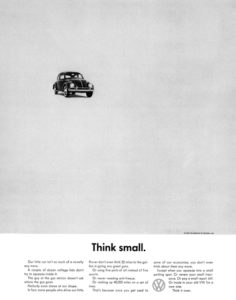
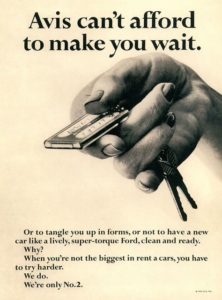
These campaigns also reveal an important change in advertising creative. Not only were ads starting to be more image-based (although the copy for the Lemon ad is exceptional), they were also starting to emotionally connect with their audience.
Take this ad from Bell Telephone which focuses on ‘lighting up the season for someone you love’ or this one for Barbie, which shows how Barbie can help your little girl grow up. Both ads use subtle emotional messages to encourage people to buy their products.
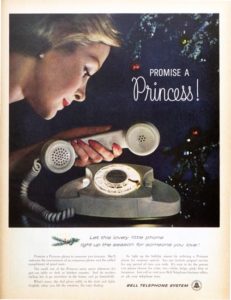
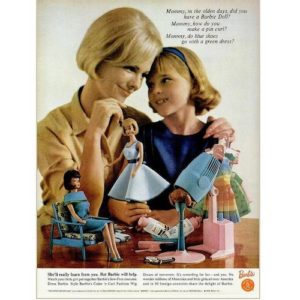
Advertisers had started to realise it wasn’t enough to rely on a brand’s Unique Selling Point, a concept invented by advertising executive Rosser Reeves in the 1950s. If they really wanted people to buy their brand, they had to create an emotional impact.
Brand building started to be a thing
The Milk Tray Man, the Cadbury Flake Girl, Hamlet cigars – all famous ad campaigns first aired in the 1960s which continued to run for years and years. The 1960s was the first real time when brands considered using consistent messaging and ideas across all their different forms of marketing material and started to develop, what would become, established brand personalities.
Brands also realised the power of using a ‘spokesperson’ to personify a brand. In the 1950s it had been common to get products endorsed by real people, such as doctors supporting cigarette ads, but this stopped once doubts were raised about the harmful effects of cigarettes. In fact, it was much safer for brands to create their own distinctive characters, so in 1963 McDonald’s first introduced Ronald McDonald to the unsuspecting public. We say unsuspecting, because, put it this way, we don’t think they spent a lot on the costume budget!
The 1960s also saw the arrival of the Pillsbury Doughboy, and of course the infamous Frito Bandito, whose racist persona resulted in a $160 million class-action law suit for malicious defamation of every US person of Spanish-speaking origin!
But racism aside, what made these characters different to the brand mascots, which had been around for decades, is they attempted to personify the brand. As Ad Age put it in 2007 about Ronald McDonald:
‘He…exemplifies one of the most important qualities of an effective
commercial character: he doesn’t sell for McDonald’s, he is McDonald’s.”
And this brand personification was made easier by the range of mass media advertising options available including TV advertising which enabled the characters to really come to life.
Young adults became the target audience of choice
Up until now, advertisers had focused on targeting adults, but that all changed in the 1960s. Young people were not only starting to form their own unique culture and set of ideals, but they also had disposable income and influence over how their parents spent their money. These factors made them a lucrative target audience for advertisers.
And this young target audience also forced advertisers to get creative. While they might have more money, many were anti-establishment, anti-materialism and desperate not to conform to societal norms, so advertisers had to find a way of tapping into those emotions.
The Pepsi Generation campaign is one of the best examples from this decade, where they focused less on selling their product, and more on creating a whole lifestyle and attitude.
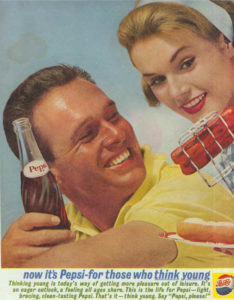
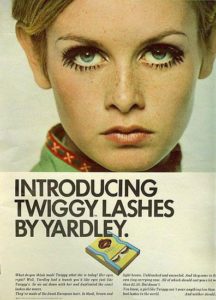
Other advertisers tried to get in on the act, with varying degrees of success. Campbell Soup went all ‘M’m! M’m! Groovy!’, Coty focused on selling body paint with their ‘What big ideas you have’ campaign and Yardley used Twiggy to sell their eyelashes.
In fact, in many ways the Volkswagen ads perfectly reflected what 1960s youth culture was all about – edgy, non-conformist and a little bit tongue-in-cheek.
Introduction of advertising regulations
With the rise in advertising, the 1960s was also marked by a sway of regulations being introduced.
From the first UK ad being broadcast in 1955, TV ads were controlled by legislation, but in 1961 the Committee of Advertising Practice was formed which regulated all forms of advertising including TV, print, direct mail and billboards. Then in 1962 the Advertising Standards Authority was launched to supervise the new system.
The 1960s in the UK also saw the ban of TV cigarette ads, the ban of infomercials, betting advertising restricted, and guidance given to the travel industry to ensure ‘holidaymakers do not suffer inconvenience, disappointment or loss’ as a result of advertisements.
Probably one of the most significant shifts reflecting how society was changing in the 60s was that restrictions were lifted on advertising pregnancy testing kits. It’s just a shame companies such as Kenwood Chef weren’t as progressive!
But then despite all the creative advances in advertising, the 60s was just the start of the ‘Golden Age of Advertising’ and there was still a long way to go.
Next time we will look at the highs and lows of the 70s and how the ad industry continued to evolve.
Meanwhile, if your brand needs a fresh coat of body paint, give us a Bell Telephone to see how we can help propel it into the 2020s!
